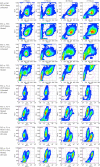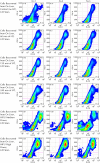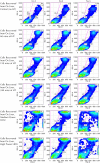Quantifying cell death induced by doxorubicin, hyperthermia or HIFU ablation with flow cytometry
- PMID: 33623089
- PMCID: PMC7902827
- DOI: 10.1038/s41598-021-83845-2
Quantifying cell death induced by doxorubicin, hyperthermia or HIFU ablation with flow cytometry
Abstract
Triggered release and targeted drug delivery of potent anti-cancer agents using hyperthermia-mediated focused-ultrasound (FUS) is gaining momentum in the clinical setting. In early phase studies, tissue biopsy samples may be harvested to assess drug delivery efficacy and demonstrate lack of instantaneous cell death due to FUS exposure. We present an optimised tissue cell recovery method and a cell viability assay, compatible with intra-cellular doxorubicin. Flow cytometry was used to determine levels of cell death with suspensions comprised of: (i) HT29 cell line exposed to hyperthermia (30 min at 47 °C) and/or doxorubicin, or ex-vivo bovine liver tissue exposed to (ii) hyperthermia (up to 2 h at 45 °C), or (iii) ablative high intensity FUS (HIFU). Flow cytometric analysis revealed maximal cell death in HT29 receiving both heat and doxorubicin insults and increases in both cell granularity (p < 0.01) and cell death (p < 0.01) in cells recovered from ex-vivo liver tissue exposed to hyperthermia and high pressures of HIFU (8.2 MPa peak-to-peak free-field at 1 MHz) relative to controls. Ex-vivo results were validated with microscopy using pan-cytokeratin stain. This rapid, sensitive and highly quantitative cell-viability method is applicable to the small masses of liver tissue typically recovered from a standard core biopsy (5-20 mg) and may be applied to tissues of other histological origins including immunostaining.
Conflict of interest statement
The authors declare no competing interests.
Figures










Similar articles
-
Interleaved Mapping of Temperature and Longitudinal Relaxation Rate to Monitor Drug Delivery During Magnetic Resonance-Guided High-Intensity Focused Ultrasound-Induced Hyperthermia.Invest Radiol. 2017 Oct;52(10):620-630. doi: 10.1097/RLI.0000000000000392. Invest Radiol. 2017. PMID: 28598900
-
High-intensity focused ultrasound-induced, localized mild hyperthermia to enhance anti-cancer efficacy of systemic doxorubicin: an experimental study.Ultrasound Med Biol. 2014 Jul;40(7):1554-63. doi: 10.1016/j.ultrasmedbio.2014.01.005. Epub 2014 Mar 15. Ultrasound Med Biol. 2014. PMID: 24642222
-
Enhancement of antitumor activity by using 5-ALA-mediated sonodynamic therapy to induce apoptosis in malignant gliomas: significance of high-intensity focused ultrasound on 5-ALA-SDT in a mouse glioma model.J Neurosurg. 2018 Dec 1;129(6):1416-1428. doi: 10.3171/2017.6.JNS162398. Epub 2018 Jan 19. J Neurosurg. 2018. PMID: 29350596
-
Focused Ultrasound Hyperthermia Mediated Drug Delivery Using Thermosensitive Liposomes and Visualized With in vivo Two-Photon Microscopy.Theranostics. 2017 Jul 7;7(10):2718-2731. doi: 10.7150/thno.19662. eCollection 2017. Theranostics. 2017. PMID: 28819458 Free PMC article.
-
Magnetic resonance guided high-intensity focused ultrasound mediated hyperthermia improves the intratumoral distribution of temperature-sensitive liposomal doxorubicin.Invest Radiol. 2013 Jun;48(6):395-405. doi: 10.1097/RLI.0b013e3182806940. Invest Radiol. 2013. PMID: 23399809
Cited by
-
Novel betulin derivatives as multidrug reversal agents targeting P-glycoprotein.Sci Rep. 2024 Jan 2;14(1):70. doi: 10.1038/s41598-023-49939-9. Sci Rep. 2024. PMID: 38167542 Free PMC article.
-
The Employment of Genera Vaccinium, Citrus, Olea, and Cynara Polyphenols for the Reduction of Selected Anti-Cancer Drug Side Effects.Nutrients. 2022 Apr 10;14(8):1574. doi: 10.3390/nu14081574. Nutrients. 2022. PMID: 35458136 Free PMC article. Review.
-
Sample Preparation of Adherent Cell Lines for Flow Cytometry: Protocol Optimization-Our Experience with SW-480 colorectal cancer cell line.Indian J Clin Biochem. 2025 Jan;40(1):74-79. doi: 10.1007/s12291-023-01161-0. Epub 2024 Jan 13. Indian J Clin Biochem. 2025. PMID: 39835228
References
-
- Engelhardt R. Rational for clinical application of hyperthermia and drugs. Rev. Med. Chir. Soc. Med. Nat. Iasi. 1987;91(2):347. - PubMed
-
- Kowal CD, Bertino JR. Possible benefits of hyperthermia to chemotherapy. Cancer Res. 1979;39(6):2285–2289. - PubMed
-
- Needham D, Anyarambhatla G, Kong G, Dewhirst MW. A new temperature-sensitive liposome for use with mild hyperthermia: Characterization and testing in a human tumor xenograft model. Cancer Res. 2000;60(5):1197–1201. - PubMed
Publication types
MeSH terms
Substances
LinkOut - more resources
Full Text Sources
Other Literature Sources

